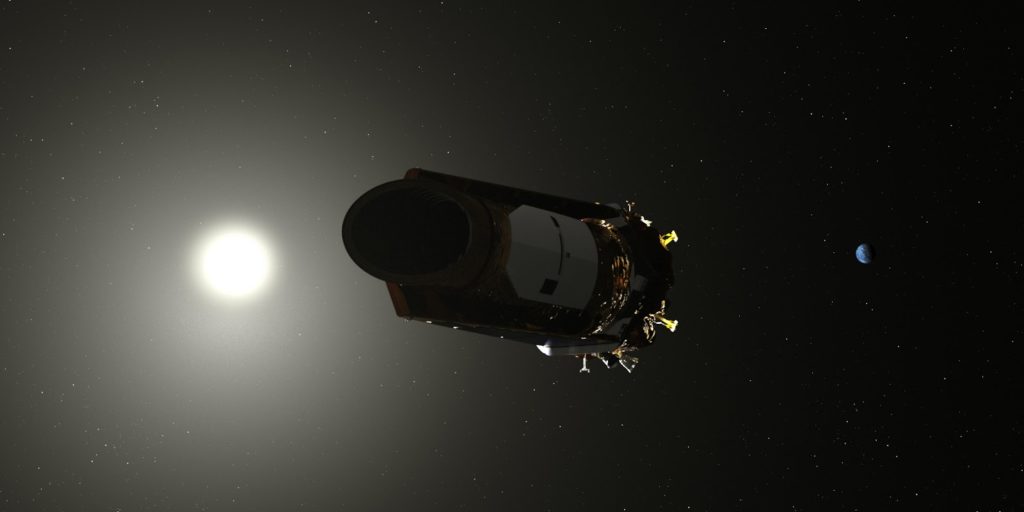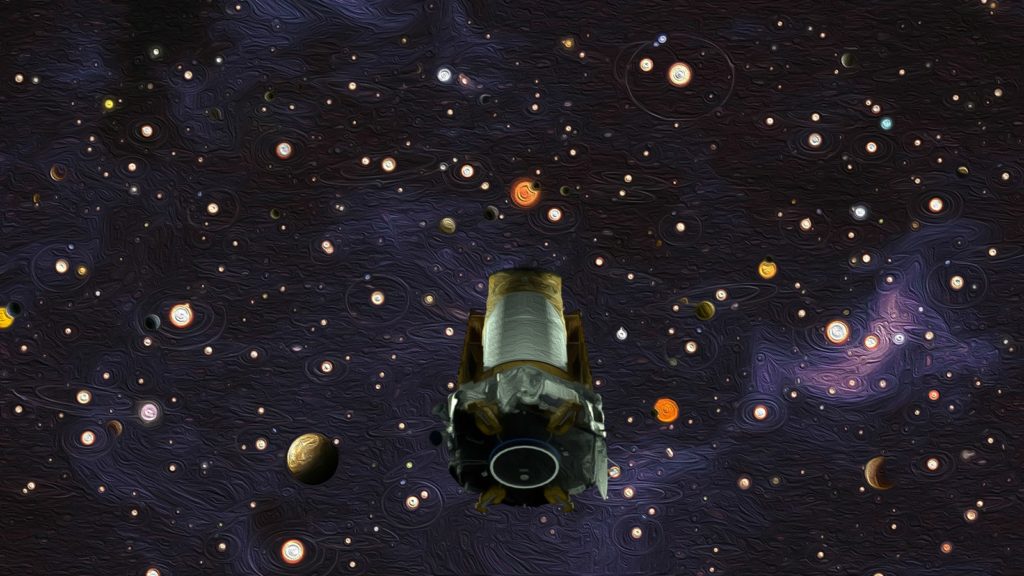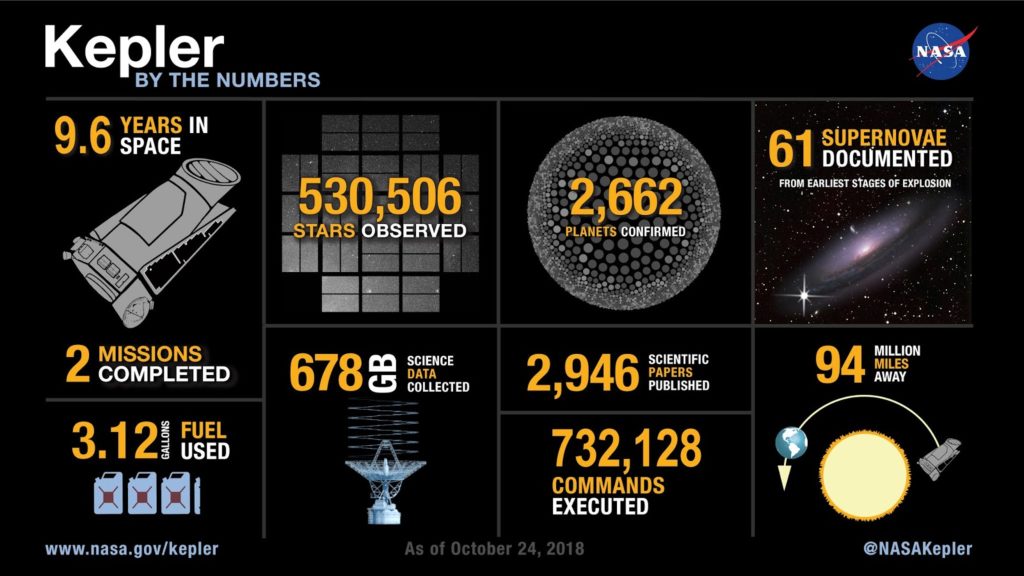CAPE
CANAVERAL, FL – NASA’s paradigm changing
Kepler exoplanet hunting mission has come to an illustrious end after discovering thousands of new planets beyond our solar system – a finding that completely changed
our concept on our place in the Universe and that continued until completely
exhausting all of its fuel reserves just days ago.
Kepler
has been retired by NASA and the planet hunting touch has been passed to recently
launched TESS.
Before
the mission began in 2009 we did not know the frequency of planets in our
Galaxy compared to stars – or whether they were common or extraordinary.
NASA
announced the retirement of Kepler at a media briefing Tuesday, October 30, saying
that not a drop of fuel was left to point the spacecraft and send any more science
data.
The
revolutionary $692 million Kepler mission lasted more than twice as long as
originally planned since it was launched in 2009.
“Kepler revolutionized our understanding of
our place in the cosmos,” said Paul Hertz, director of astrophysics
at NASA Headquarters at the Oct. 30 media briefing.
know if planets were common or rare in our galaxy,” he said. “We didn’t
know much about planets. But now we know there are more planets than stars in
our galaxy. Planets are more common than stars.
“Because of
Kepler, we know that planets are an incredibly diverse set of objects,
much more diverse than we observe in our own solar system. And because of
Kepler, we know that solar systems come in a variety of configurations unlike
our own. Solar
systems with Jupiters orbiting their stars in only a few days, solar systems
with small, rocky planets packed inside the orbit of Mercury, so close that the
planets are in resonance with each other.”
unknown in our solar system that vary in size between Earth and Neptune – and that
they are actually among the most common type of planet.
the common kinds of planets that Kepler detected are planets that are larger
than Earth and smaller than Neptune, a type of planet that doesn’t exist in our
own solar system.”
hunt for Exoplanets to NASA’s recently launched TESS.”
 |
|
Artist’s conception of
NASA’s Kepler Space Telescope. Credits: NASA |
Kepler mission has been an enormous success,” said the Kepler mission’s founding principal
investigator, William Borucki, at the briefing, and now retired from NASA’s
Ames Research Center in California’s Silicon Valley. He conceived the mission
35 years ago and finally won approval from NASA in 2001 on his 5th
try!
shown there are more planets than stars in our galaxy, that many of these
planets are roughly the size of the Earth and some, like the Earth, are at the
right distance from their star that there could be liquid water on the surface,
a situation conducive to the existence of life.”
June. So the team knew the end was near and quickly downloaded all the science
data so that nothing would be left behind on the spacecraft and lost to humanity.
that indicate our sky to be filled with billions of hidden planets – more
planets even than stars – NASA’s Kepler space telescope has run out of fuel
needed for further science operations,” NASA announced.
within its current, safe orbit, away from Earth. Kepler leaves a legacy of more
than 2,600 planet discoveries from outside our solar system, many of which
could be promising places for life.”
To date Kepler’s
observations have confirmed the existence of 2,681 new planets orbiting other
stars. There are another 2,899 planet candidates awaiting confirmation pending
observations from ground and space-based telescopes.
years ago we didn’t know of a single planet outside our solar system,” said Borucki.
Kepler has set us on a new course that’s full of promise for future generations
to explore our galaxy.”
that are rocky like the Earth and are orbiting their stars in the habitable
zone, or the Goldilocks zone, where their temperatures might be conducive to
water on the surface.”
telescope told us about those planets?
there is no consensus yet.”
“But new data from the GAIA probe has forced us
to rethink the distance of these planets to the host stars. It seems now these
stars may be brighter, hence the planets are bigger,” Hertz told me..
and 12 Earth like worlds that could potentially support life.”
planets – looking for a very slight dimming of 1/10,000 of a star’s brightness
as a planet moved in front from a distance of 100 miles.
the transit method “is like trying to detect a fly crawling across a car
headlight when the car was 100 miles away. And the instrument must do it
for 150,000 stars simultaneously,” Borucki explained.
rocket March 6, 2009, “the Kepler space telescope combined cutting-edge
techniques in measuring stellar brightness with the largest digital camera
outfitted for outer space observations at that time. Originally positioned to
stare continuously at 150,000 stars in one star-studded patch of the sky in the
constellation Cygnus, Kepler took the first survey of planets in our galaxy and
became the agency’s first mission to detect Earth-size planets in the habitable
zones of their stars.”
innovative design. It was an extremely clever approach to doing this kind of
science,” said Leslie Livesay, director for astronomy and physics at NASA’s
Jet Propulsion Laboratory, who served as Kepler project manager during mission
development. “There were definitely challenges, but Kepler had an
extremely talented team of scientists and engineers who overcame them.”
pushed Kepler to its full potential, said NASA
observation campaigns and downloading valuable science data even after initial
warnings of low fuel. The latest data, from Campaign 19, will complement the
data from NASA’s newest planet hunter, the Transiting Exoplanet Survey
Satellite, launched in April. TESS builds on Kepler’s foundation with fresh
batches of data in its search of planets orbiting some 200,000 of the brightest
and nearest stars to the Earth, worlds that can later be explored for signs of
life by missions, such as NASA’s James Webb Space Telescope.”
end, we didn’t have a drop of fuel left for anything else,” said Charlie
Sobeck, project system engineer.
exhaustion, the Kepler spacecraft has reached the end of its service
life,” he explained
this may be a sad event, we’re by no means unhappy with the performance of this
marvelous machine. Kepler’s nine-and-a-half-year flight was more than twice the
original target.”
Boeing, Lockheed Martin, Northrop Grumman and more space and mission reports direct
from the Kennedy Space Center, Cape Canaveral Air Force Station, Florida and
Wallops Flight Facility, Virginia.
and human spaceflight news: www.kenkremer.com –www.spaceupclose.com –
twitter @ken_kremer – email: ken at kenkremer.com
scientist and journalist based in the KSC area.
Ken’s photos are for sale and he is available for lectures and outreach events



